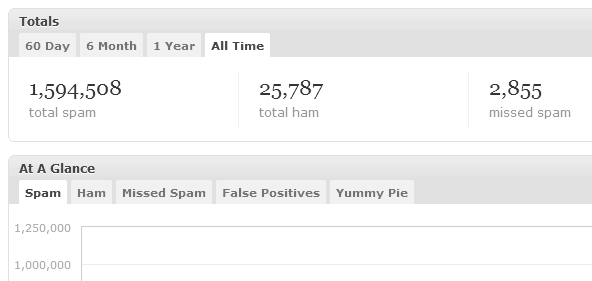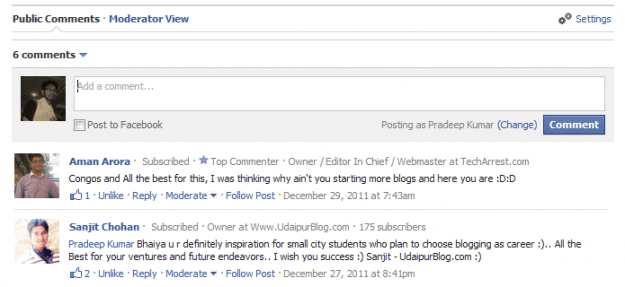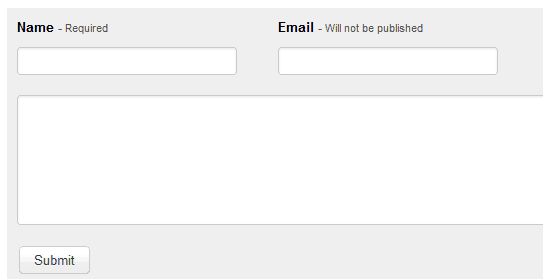If you are like me or like anyone using a WordPress blog, then you’ll be even ready to pay to prevent spam comments. Because that spoils almost 30% of our energy we give for our blog. Few plugins + few tweaks, you are ready to enter a spam-free dashboard then. Using such tips you can prevent them as much as possible because I have tried them on my blog(s) and it worked quite well. So I thought of making an article with all those tips combined, and here it is.
1. Use Akismet
Akismet is a MUST have plugin for a typical WordPress blog. If you don’t have it, then you’ll have the burden of differentiating genuine comments and spam comments. Akismet filters out your comment and track-back spam for you.

2. ReCAPTCHA
Before going to ReCAPTCHA I’ll tell you what CAPTCHA is. It is a type of challenge-response test used in computing as an attempt to ensure that the response is generated by a person. You can try lots of CAPTCHA plugins to prevent spammers from automatically entering the comments. You can also try Math Comment Spam Protection, which asks the visitor making the comment to answer a simple math question instead.

3. Blacklist certain words
You can find this option on WordPress “Discussion Settings”. You can keep a list of words you don’t want to have in your blog comments, if you get any such comments it will be moderated. Like when a comment contains any of those words in its content, name, URL, e-mail, or IP, it will be marked as spam. You can use the similar kind of form in the Comment Moderation if you want to moderate them instead of marking as SPAM.

4. Use Third Party Commenting Systems
I don’t have much experience but third party commenting systems like Disqus, Intense Debate, Facebook Comments, etc have good control over SPAM comments. Interestingly such commenting systems are not loved by spammers, they rarely poke their heads inside such systems.

Common Blog Comment Systems
- Disqus
- IntenseDebate
- Livefrye
- Facebook Comments
5. Avoid DoFollow
Spam commentators normally target dofollow blog because they’ll get more advantage over nofollow blogs. Comments on a dofollow blog have more juice and traffic. So you can make your dofollow blog as nofollow if you get lots of spam comments frequently. Though being a dofollow blog has some advantages you still need to battle the spam comments now and then.
6. Use Comments Policy
Every blog must have a “Comments Policy“, because that’ll help your readers and commentators to know the right format and way to comment on your blog. You can mention what happens if they spam on your blog. You can also tell how you reward them (learn how to reward commentators) for their genuine comments and why they should not spam instead.
7. Ban by IP
This WordPress plugin WP-Ban is a recommended one. If you find any person from a particular IP address continuously spamming your blog, then you can ban them using this.
It will display a custom ban message when the banned IP, IP range, host name or referer url trys to visit you blog. You can also exclude certain IPs from being banned. There will be statistics recordered on how many times they attemp to visit your blog. It allows wildcard matching too. You can also use the default WordPress comment moderation to ban IP addresses.
WordPress Plugin Used:
8. Use CommentLuv and KeywordLuv
Confused? The thing is, if you use such plugins normal readers won’t bother to fill their comments with spam content (like links). Instead they’ll use plugins like CommentLuv and KeywordLuv to fulfill their desires.
WordPress Plugins Used:
- CommentLuv
- KeywordLuv
9. Confirm you are not a spammer
Believe me, this plugin is equal to Akismet. GrowMap Anti-Spambot Plugin (G.A.S.P.) is what we are talking about. You just have to confirm that you are not a spammer using a check box.
WordPress Plugin Used:
10. Close comments on old posts
If you wish to close comments on older posts you can do that on WordPress “Discussion Settings”. Just go there and under “Other comment settings” you can find “Automatically close comments on articles older than ___ days”.

Enter the age of the posts you want the comments to be closed and save. WordPress also provides the option to close comments on individual posts you can use of that. Because spammers target posts with high traffic.
11. Cookies for Comments Plugin
This WordPress plugin will set a cookie on a random URL that is then checked when a comment is posted. If the cookie is missing the comment is marked as spam.
This plugin adds a stylesheet or image to your blog’s html source code. When a browser loads that stylesheet or image a cookie is dropped. If that user then leaves a comment the cookie is checked. If it doesn’t exist the comment is marked as spam. The plugin can also check how long it took a user to enter a comment. If it is too fast it could probably be a spam bot.
WordPress plugin used:
12. Custom WP function to ban empty referrers
This function will reject the comments from the browsers which do not have referrers enabled. When the ‘referrer’ for a particular comment request is empty, then obviously the comment is not posted from your blog post comment form.
RewriteEngine On
RewriteCond %{REQUEST_METHOD} POST
RewriteCond %{REQUEST_URI} .wp-comments-post.php*
RewriteCond %{HTTP_REFERER} !.*yourblog.com.* [OR]
RewriteCond %{HTTP_USER_AGENT} ^$
RewriteRule (.*) ^http://%{REMOTE_ADDR}/$ [R=301,L]
Paste this code on your .htaccess file. Please kindly backup your .htaccess file before implementing this.
13. Simple trackback validation
You can also validate the trackbacks you are getting for your blog posts. You can check whether they are coming from original source or some crap site. Simple Trackback Validation Plugin performs a simple but very effective test on all incoming trackbacks in order to stop trackback spam.
This plugin checks if the IP address of the trackback sender is equal to the IP address of the webserver the trackback URL is referring to.
WordPress Plugin Used:
14. Remove website column
Pretty simple way to avoid all sorts of SPAM comments. It will be hard for the spammers to keep your blog in their hit list then.

This screenshot of Woorkup.com shows comment form without website column. So normally spammers will give less preference to such sites, but it might also make link building readers aka commentators confuse.
15. Avoid HTML in comment
This tip will help you to disable HTML inside comments. Even if the commentator uses “HTML” syntax, they won’t convert. Commentators will normally keyword related anchor texts and make them as spam comments. By disabling HTML, you can make them look like normal text instead of clickable links.
Reference:
16. Add Invisible formfields to Comment form
By adding additional formfields to your comment form (which is only invisible to humans) you can differentiate between a normal comment and bot comment. If a spambot fills these fields blindly (which most of all spambots do), the comment will not be saved. You can use NoSpamNX WordPress plugin for this.
You can decide if you want to block these spambots or mark them as spam. Furthermore, you can put common spam-phrases on a local Blacklist or (if you have multiple Blogs) on a global Blacklist. This comes very handy when fighting againt “handmade” Spam.
WordPress Plugin Used:
17. Moderate first time commentators
You can restrict first time commentators from getting approved instantly. You can enabled the option that Comment author must have a previously approved comment by the administrators. You can see this on Discussion Settings > Before a comment appears.

18. Comment Email Verification
If a comment is held for moderation then an email message will be sent to the comment author with a link to verify his/her email address. When the comment author clicks on that link the comment gets approved immediately. This makes discussions more lively as users don’t have to wait for the blog admin to approve the comment.
Blog owners may also choose to hold the comments in the moderation queue even after successful verification. The verification status is shown in the comment lists in the admin.
WordPress Plugin Used:
19. Restrict Comments to Registered Users
If you have enabled registration on your WordPress blog, then you can restrict comments to only registered users.

Go to the Settings > General panel > Under Membership:, select Users must be registered and logged in to comment. This will reduce good amount of spam since you can get genuine users by registering.
20. Limit Number of Links in Comments
Mostly spam comments will have links in comments so you can limit the number of links in the comments to avoid spamming.

To change the number of links in comment posts you can change the setting for the number of links permitted in a comment.
Go to the Settings > Discussion panel.
Scroll down to Comment Moderation.
In the section which covers the number of links in a post, it is set to 2 by default. You could lower to one.
NOTE: Do not set this to zero or leave the field blank. It will send every comment to moderation — not the desired effect.
21. Disable Comments & Trackbacks
This is not a tip to reduce spam comment, but to disable comments. Just uncheck the last two options to disable comments and trackbacks for your blog posts. No more SPAM comments. If you are really not interested in these comments thing, then this is the best option for you. 🙂
Settings > Discussion > Default article settings

You can also delete your wp-comments-post.php and wp-trackback.php to disable comments and trackbacks permanently.
I’m sure these tips will help you to reduce spam comments on your WordPress blog. If you know any other tip, kindly mention them in the comments.










I think Akismet is the simplest way to reduce spam comments on your blog. And BTW, I liked the other tips a lot. Will use them for sure 😀
Spam is the worst thing i ever found online. I hate spam and Hacking both. For spam i use Askimat plugin in wordpress.
Now taking about spam these days its a ridiculous thing, i got around 500 spam comments in a days.
Akismet is the best, I have four blogs and akisment work like a charm in blocking SPAM. AKI ROCKS!!!
That’s one long list of things to do to avoid spam, do you do all of them on this blog?
Nope, not all of them, but some few essential techniques. 😉
Acquiring a lot of comments means that your blog is reaching more readers. But more often, comments from blogs are SPAM. Getting rid of these spam comments is important in order to build your blogs reputation.
The best way to reduce Spam comments is to close the comments form after a few weeks that you have posted your article. This along with the other options stated above will help your users reap gold from the comments section of each post and not spam. Thank you for the help!
Great review of all the posibilities.
I am using Akismet and it really helps to lower the number of spam, I recommend it to everyone.
Yea, we really need 21 ways to prevent spam. It’s really annoying
Thats really super. I am using GASP AKISMET and Conditional Captcha.
Its working fine for me to proctect with Spam Comments as well as Spam Trackbacks.
Thanks Pradeep for sharing this superb tips.
Yes Keywordluv is best on all ways. Thanks for the list.
Almost all of us really hate spammers. Some people easily gets annoyed with those spams. This post is very useful since people don’t want to have spams. Great post!
Great list of plugins, I personally use recpatcha but I’m not that much happy with it. And what about that ban by ip, is it any good, I was looking for plugin like that? Because once you ban the ip of the spammer you can sleep better. It certainly looks easier then doing it with settings – discussion and entering ips.
thanks for sharing
Yea James, that is a good one. You can also find that feature in WordPress “Discussion Settings”. 🙂
is there any method for blogger to avoid spam?
Google’s Blogger platform by default provides good SPAM comment combat system mate. 🙂
Wow, 20+ methods which we can use to reduce spam comments. I have never thought of some of these methods. Anyway, I think the easiest and most effective is just to use Akismet.
is there anyway to stop spam as i did all of these n then also my blog gets spam comments
Did you try this plugin?
http://www.growmap.com/growmap-anti-spambot-plugin/
Even after using this you are facing more spam comments comparatively?
Akismet+Growmap Anti Spambot Plugin+Captcha plugin can stop most of the spam comments.
Thats a really huge one, very tips to fight against spam. One more thing I can see my comment in the facebook comments image hehehehe.
I think I did that comment on hostlater.com 😀
Cool bro, I guess that was on Slashsquare.
can be on slashsquare also, maybe on the launch article that you cross posted from hostlater 🙂
Very good post. Currently I’m using Akismet & Disqus commenting system. They are completely helping me to fight against spam. Again spam is totally no because of penguin update. So, we should always accept those comments that have value in it. I’ll also suggest to use facebook commenting system as very few will then spam using it.
Any way to make sure real comments don’t go to spam? Been having some trouble with it.
Akismet has a database with blacklisted IPs, email addresses, and some words mate, if someone comments using those details then it’ll obviously enter into SPAM section.
Thank you for mentioning the GrowMap antispambot plugin. The reason it exists is because there is no way to make sure Akismet does not put your best comments into the spam area along with tons of spambot left comments. Any person who comments frequently ends up being flagged as a spammer by Akismet because there is no consensus about what spam is.
Some bloggers will send any comment they don’t like or any comment that links to any business or any comment from someone they don’t already know to spam. When they do that they get you blacklisted – and there is no way to educate the entire blogosphere about what really is and isn’t spam. There isn’t even any agreement among serious professional bloggers about what spam is.
If you use Akismet at least use GASP too because that way you won’t miss the real comments lost in among all the spam. GASP is free and thousands of bloggers are using it.